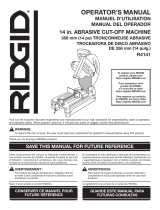
work that creates dust. Close the cap over the
dust removal connector.
e) Improve the blood circulation in your fingers by
relaxing your hands and exercising your fingers
during breaks between working.
f) Avoid touching rotating parts. Switch the power
tool on only after bringing it into position at the
workpiece. Touching rotating parts, especially ro-
tating drill bits, discs or blades, etc. may lead to
injury.
g) Always lead the supply cord and extension cord
away from the power tool to the rear while work-
ing. This helps to avoid tripping over the cord while
working.
h) The guard must always be fitted when the power
tool is used for cutting metals. Close the cap over
the dust removal connector.
i) If the work involves breaking right through, take
the appropriate safety measures at the opposite
side. Parts breaking away could fall out and / or fall
down and injure other persons.
j) Children must be instructed not to play with the
machine.
k) The machine is not intended for use by children,
by debilitated persons or those who have received
no instruction or training.
l) Do not use the power tool if it starts with a jolt.This
may be an indication that the electronic control unit
is defective. Have the power tool repaired by Hilti
Service immediately.
m) WARNING: Some dust created by grinding, sand-
ing, cutting and drilling contains chemicals known
to cause cancer, birth defects, infertility or other
reproductive harm; or serious and permanent res-
piratory or other injury. Some examples of these
chemicals are: lead from lead-based paints, crys-
talline silica from bricks, concrete and other masonry
products and natural stone, arsenic and chromium
from chemically-treated lumber. Your risk from these
exposures varies, depending on how often you do
this type of work. To reduce exposure to these
chemicals, the operator and bystanders should
work in a well-ventilated area, work with ap-
proved safety equipment, such as respiratory pro-
tection appropriate for the type of dust generated,
and designed to filter out microscopic particles
and direct dust away from the face and body.
Avoid prolonged contact with dust. Wear protec-
tive clothing and wash exposed areas with soap
and water. Allowing dust to get into your mouth,
nose, eyes, or to remain on your skin may promote
absorption of harmful chemicals.
5.4.2 Power tool use and care
a) Cutting discs must be stored, handled and fitted
carefully in accordance with the manufacturer’s
instructions.
b) If use of a spacer ring or other intermediate part is
specified and the part is supplied with the cutting
disc, check to ensure that the part is fitted.
c) Secure the workpiece. Use clamps or a vice to
secure the workpiece. The workpiece is thus held
more securely than by hand and both hands remain
free to operate the machine.
d) Before use, check that the cutting disc has been
fitted correctly and the clamping nut tightened.
Then allow the power tool to run for 30 seconds
under no load while holding it in a secure po-
sition. Switch off the power tool immediately if
significant vibration or any other faults are no-
ticed. Should this occur, check the entire system
in order to determine the cause.
e) Take steps to ensure that flying sparks from the
power tool do not present a hazard, i.e. by striking
yourself or other persons. Adjust the position of
the disc guard accordingly.
f) Slits cut in loadbearing walls of buildings or other
structures may influence the statics of the structure,
especially when steel reinforcing bars or load-bearing
components are cut through.
Consult the structural
engineer, architect, or person in charge of the
building project before beginning the work.
g) Guide the power tool carefully and make straight
cuts in order to avoid jamming the cutting disc.
Cutting curves is not permissible.
h) Guide the power tool evenly and do not apply
lateral pressure to the cutting disc. Always bring
the power tool into contact with the workpiece
at right angles. Do not attempt to alter the line
of cut by applying lateral pressure or by bending
the cutting disc while cutting is in progress. This
presents a risk of damaging or breaking the cutting
disc.
5.4.3 Electrical safety
a) Before beginning work, check the working area
(e.g. using a metal detector) to ensure that no
concealed electric cables or gas and water pipes
are present. External metal parts of the machine may
become live, for example, when an electric cable is
damaged accidentally. This presents a serious risk of
electric shock.
b) Check the machine’s supply cord at regular inter-
vals and have it replaced by a qualified specialist
if found to be damaged. If the machine’s sup-
ply cord is damaged it must be replaced with
a specially-prepared supply cord available from
Hilti Customer Service. Check extension cords at
regular intervals and replace them if found to be
damaged. Do not touch the supply cord or exten-
sion cord if damaged while working. Disconnect
the supply cord plug from the power outlet. Dam-
aged supply cords or extension cords present a risk
of electric shock.
c) Dirty or dusty machines which have been used fre-
quently for work on conductive materials should
be checked at regular intervals at a Hilti Service
Center. Under unfavorable circumstances, damp-
ness or dust adhering to the surface of the ma-
en
8
Printed: 08.07.2013 | Doc-Nr: PUB / 5069501 / 000 / 01




















